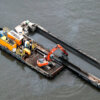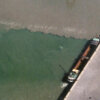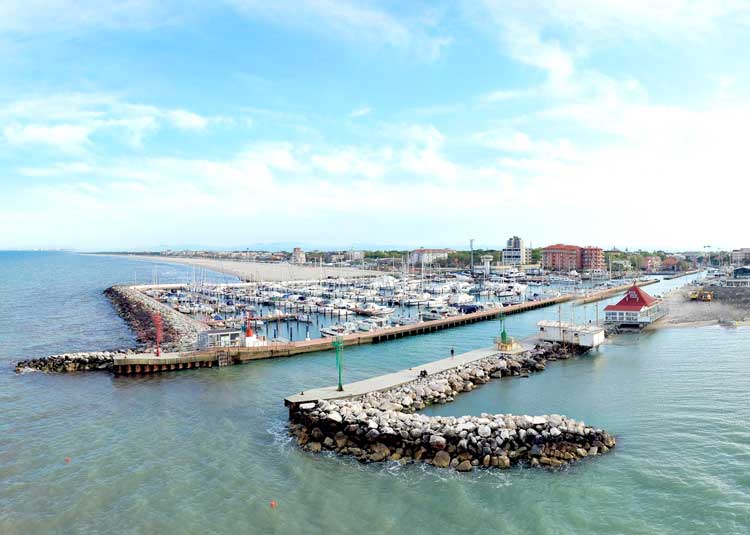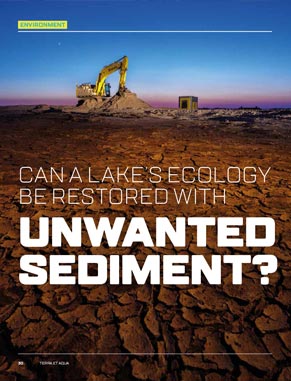Sustainability means acting in a way that is not harmful to the planet, preserves natural resources, and thus supports long-term ecological balance.
Renewables and non-renewables
One guideline to sustainability defines three aspects of resources: non-renewable, renewable and waste disposal. This can be summarised as:
- the depletion of a non-renewable resource should require the development of a renewable substitute for that resource.
- the rate of harvesting renewable resources should not be greater than the rate at which new resources are regenerated;
- the amount of waste generated from a project should not be greater than the ability of the environment to assimilate the waste.
In short sustainability is the ability to use natural resources without completely using them up or destroying them, employing methods which are compatible with preserving them, and ensuring that what is built will last for a long time.
Dredging & sustainability
The World Organization of Dredging Association (WODA) has adopted a series of principles that define the meaning of sustainable dredging. The principles emphasise that dredging helps to improve people’s quality of life and economic well-being by creating and maintaining essential water-based infrastructure. This includes:
- navigation dredging and land reclamation;
- enhancing environmental quality by beach nourishment;
- environmental (remediation) dredging to remove contaminated sediments;
- providing flood control;
- producing minerals and construction materials (sand); and
- supporting offshore energy production, including renewable energy.
By adhering to principles of sustainability for dredging and dredged material management using natural systems to integrate these actions, the dredging industry believes that the goals of environmental quality and economic prosperity can both be achieved.
WODA’s objective is to achieve sustainable dredging through implementation of the following:
- From the start and throughout all stages of a dredging project, social, environmental and economic objectives should be considered and integrated.
- When developing a project design, parties should identify how to work with natural processes and recognize the site-specific characteristics of ecosystems as well as understand the carbon footprint of the dredging project.
- Project proponents, regulatory authorities and all stakeholders should be engaged at the earliest conceptual stage in the project’s development. Active collaboration is the key to achieving maximum social, environmental and economic benefits.
- Scientifically based criteria, performance guidelines and environmental safeguards for dredging and dredged material management should provide clear directions to project owners, planners and executing companies.
- Dredged material management should be based upon a holistic, systematic understanding of the ecosystem and natural processes at the project. Beneficial use of dredged materials should be given priority.
- Dredging can be a key solution for remediation and restoration at historically contaminated aquatic sites.
- Analysis of monitoring and assessment information before, during and after project implementation provides a basis for effective and sustainable project management.
The application of these principles will continue to help the dredging industry find sustainable solutions in the marine environment.
Subjects
Environment
-
 Building with Nature
Building with Nature
-
 Climate Change
Climate Change
-
 CO2 & Other Emissions / Greenhouse Gases
CO2 & Other Emissions / Greenhouse Gases
-
 Coastal Protection
Coastal Protection
-
 Confined Disposal Facilities
Confined Disposal Facilities
-
 Coral Reefs
Coral Reefs
-
 Deltas
Deltas
-
 Ecosystem Services
Ecosystem Services
-
 Environmental Impact Assessment
Environmental Impact Assessment
-
 Environmental Monitoring
Environmental Monitoring
-
 Environmental Monitoring and Management Plans
Environmental Monitoring and Management Plans
-
 Flood Defence
Flood Defence
-
 Management Practices for the Environment
Management Practices for the Environment
-
 Mangroves
Mangroves
-
 Remediation dredging (Contaminated sediments)
Remediation dredging (Contaminated sediments)
-
 Sustainability
Sustainability
-
 Turbidity
Turbidity
-
 Underwater Sound
Underwater Sound
-
 Wetlands
Wetlands
related
Articles
Waste heat recovery on dredging vessels

Limiting global warming requires the maritime sector to transition to a more efficient and sustainable operation. Reducing greenhouse gas (GHG) emissions, such as carbon dioxide and methane is vital to limit the global temperature rise (IPCC, 2021). Several legislative initiatives are in effect or are being discussed, including the IMO GHG strategy and the FuelEU Maritime initiative. This article discusses the potential of waste heat recovery (WHR) technologies to reduce the fuel consumption of dredging vessels. Available WHR technologies are compared based on working principle and operational performance for different types and ratings of internal combustion engines.
Evaluation of a nature-based agitation dredging solution

The challenge of maintaining harbours and ports while conserving and sustaining coastal habitats, with all the rich resources they provide, requires that port and harbours do more to develop approaches to maintenance dredging that provide benefit to these neighbouring habitats. In this article, we describe an example from Harwich Harbour in the UK where Harwich Haven Authority (the Conservancy Authority) is looking to move to a more nature-based maintenance dredging methodology, using agitation dredging. Using the results of monitoring and sophisticated numerical modelling, we evaluate the likely benefit to the Stour/Orwell intertidal areas arising from the use of the agitation dredging.
The importance of flocculation in dredge plume modelling

Numerical models are often used to predict the magnitude and behaviour of dredge plumes to help assess and manage any environmental risks. To provide a realistic prediction of plumes resulting from dredging, numerical models require information on the rate at which sediment is suspended by the dredging, along with the characteristics of the suspended sediment. Previous investigations have shown that in the marine environment, fine-grained sediment suspended by natural processes and dredge-related activities are typically present as aggregated particles known as flocs. This article considers the importance of including the process of flocculation in dredge plume models.
Reinforced soil – the quay wall structure for the future?

Steel and concrete are the most common materials used in quay wall structures. The application of these materials contributes to a high emission of greenhouse gasses such as CO2 and the materials make up a large part of the construction costs. This graduate research examines whether alternative quay wall structures have the potential to be more cost effective and more sustainable compared to conventional structures for inland ports. An innovative quay wall of reinforced soil was designed and quay elements implemented to make a quay wall structure. A comparison was then made based on the criteria costs and sustainability between the innovative quay design and two conventional quays.
Deploying private capital to accelerate the green transition

Green solutions in ports, waterways and coastal projects have increasingly become available thanks to many years of research and pioneering efforts in practice. These sustainable and/or nature-based solutions have shown to be good alternatives for classic solutions, but application is far from mainstream yet. One of the major hurdles is the lack of access of private capital to finance these kinds of solutions despite the strong interest of capital markets in green infrastructure opportunities. Identifying the hurdles and paving a way forward to overcome these hurdles could therefore help to increase the uptake of those green solutions.
Climate Risk Overview tool: mapping naturebased flood protection opportunities

The planet is facing enormous challenges caused by human activity, increasing the vulnerability of communities and ecosystems to the forces of nature. This is worsened by the effects of climate change, which is threatening the world’s coastal defences. Van Oord has responded to these challenges by developing the Climate Adaptation Action Plan. The plan is designed to encourage meaningful dialogue between stakeholders in order to provide ready-to-scale marine solutions that help increase the resilience of the communities and ecosystems of coastal areas.
Shaping the engineers of tomorrow

During his distinguished career as professor of Coastal Engineering at Delft University of Technology (TU Delft), Kees d’Angremond served as head of Hydraulic and Offshore Engineering, chair of the department of Hydraulic and Geotechnical Engineering, and dean of the faculty of Civil Engineering from 1989 to 2001. Now professor emeritus, he still works as an advisor and independent consultant. We invited Kees to a conversation with Stefan Aarninkhof, professor of Coastal Engineering and chair of the department of Hydraulic Engineering at TU Delft, to talk about their careers in the dredging industry and the role of academia in the industry today.
The impact and costs of Building with Nature projects

The use of nature and natural processes is an innovative way to increase water safety and create added value through nature development and recreation. This exploratory study provides an initial inventory of the impact and costs of existing Building with Nature projects in the Netherlands. It also includes an analysis of the decision-making process in choosing this type of project and identifies success factors. Building with Nature projects deliver added value but often also involve additional costs compared to traditional reinforcements. These costs give an indication of what we as a society are prepared to pay for the development of nature and recreation as part of hydraulic engineering projects.
The valuation of externalities in maritime infrastructure projects

Climate change and increasing environmental damage are demonstrating the urgency of transformation to a sustainable global economic model. The implementation of the sustainable development concept tends to narrow to integrating environmental, social, and economic concerns in the decision making. In economics, the definition of such concerns is an externality that represents the divergence between social and private costs. This study investigates the available sustainable asset valuation methods that can include the externalities materialised in maritime infrastructure projects and compares them based on economic, social and environmental criteria.
The responsible project: A view on social licence

In today’s world, expectations for sustainable practices are fast becoming the norm. Countries, the public and communities are requesting transparency, the application of higher environmental standards and involvement in decision-making processes when new developments in a marine environment are proposed. Marine infrastructure projects not only require environmental permits and works licences to be in place, they also need a Social Licence to Operate (SLO). This article describes the social licence in this fast-changing context of information and technology, and explores tools that can be used to develop a ‘responsible project’ and provide a successful and sustainable outcome for society and the environment.
Creating mangrove habitat for shoreline protection

Over the past decades, there has been a growing interest in exploring innovative ways to minimise the environmental footprint of coastal developments and in nature-based approaches for shoreline protection. At Mubarraz Island near Abu Dhabi (UAE), an international oil company beneficially reused ~12 million m³ of dredged material to protect pipelines, construct a causeway and create mangrove habitat to manage coastal erosion. This ‘Working with Nature’ approach has provided a cost-effective nature-based solution for shoreline protection, with added benefits for biodiversity conservation.
LIFE MARINAPLAN PLUS Project: Sustainable marine and coastal seabed management

In June 2019, the research team of the LIFE MARINAPLAN PLUS project began operating the first-of-a-kind demonstration plant installation at the harbour entrance of Marina di Cervia (Italy). Fulfilling the project’s objective to apply at industrial scale a reliable technology for the sustainable management of sediment in marine infrastructures, this technology prevents harbour silting through the use of submerged devices called ‘ejectors’ installed on the seabed.
Interview: Stéphanie Groen, Director of Coastal & Climate Change in Asia for Aurecon in Singapore

Stéphanie Groen works as the Director of Coastal & Climate Change, Asia for Aurecon. Based in Singapore, she was appointed to the position at the beginning of 2020. Previously, Stéphanie was involved in marine and environmental projects for more than 15 years with DHI and her education is in civil engineering and business administration. IADC also knows Stéphanie as the winner of the Young Author Award in 2007. More recently, she was appointed as a committee member to the prestigious FIDIC Sustainable Development Committee. We were interested to hear more from Stéphanie – her views on sustainability, the collaboration with the dredging industry through FIDIC and what her new role can mean for sustainable water infrastructure projects.
Land reclamation: The potential for subsurface freshwater storage

At present too little use is made of the opportunities that the design and construction of land reclamation offer for the underground storage and recovery of fresh water. The managed aquifer recharge systems in the coastal dunes of the Netherlands are a good example of successful subsurface water storage. And it is to be expected that the sandy deposits of land reclamations could serve a similar purpose. This in turn will contribute to a sustainable development of land reclamations.
Interview: Panama Canal’s deputy administrator Ilya Espino de Marotta

Armed with degrees in both Marine Engineering and Engineering Economics as well as 35 years – and counting – of experience at the Panama Canal Authority, Ilya Espino de Marotta has blasted through the glass ceiling wearing a pink hard hat. Amongst the diverse roles she has under her belt, ranging from Marine Engineer in the shipyard to Vice President for Transit Business, Ilya has notably led the Canal’s expansion as head engineer and now oversees operations from the second highest position at the authority.
How can the dredging sector join the global shift towards sustainability?

A paradigm shift is being increasingly embraced within the dredging industry. The traditional engineering approach is becoming a holistic approach in which the ecosystem is leading and values for people, profit and planet are integrated in an interdisciplinary manner.
Building with Nature: Sustainable Protection of Mangrove Coasts

Building with Nature is an innovative approach that combines natural processes with innovative engineering methods to realise sustainable projects. Permeable dams are being utilised as part of a Building with Nature solution to help restore the eroding mangrove-mud coast of the Demak district in central Java, Indonesia.
News
Panel session at the UN Science, Policy and Business Forum on the Environment

March 10: panel session hosted by IADC, CEDA and PIANC at the UN Science, Policy and Business Forum on the Environment in Nairobi. The UN Science, Policy and Business Forum on the Environment will convene its second global session in Nairobi, Kenya, from March 8-10, 2019 in the lead up to the Fourth Session of the UN Environment Assembly. The forum’s work is aligned with the theme of the assembly: Innovative solutions for environme
Publications
Videos
Presentation: ‘Hondsbossche and Pettemer Sea Defence an example of sustainable asset valuation’ by Sven Kramer (Van Oord) − Director Sustainability

This presentation shows the practical implications of taking all externalities into consideration as early as possible in a project procedure. It is complex but asset valuation is gradually becoming more and more feasible for large infrastructure projects. The independent International Institute of Sustainable Development carried out a study on the benefits of “Nature Based” coastal Protection compared to traditional “Grey” solutions. Their report is expected to be published mid-November 2021.
Presentation: ‘There is ”more” in maritime infrastructure‘ by Marc Huygens (DEME) − Environmental Manager

There are opportunities to develop and implement new solutions for maritime infrastructure challenges. In addition to technical-economical values there is a big commitment to create both environmental and social values. To take the industry to the next level it is necessary to attract students and young professionals to the industry to ensure all externalities are taken into consideration from the onset of a project. The “Social Benefits Wheel” is a tool that can help track the degree to which a project or programme is attaining its social development targets and goals.
Presentation: ‘Sand as a Resource’ by Jan Fordeyn (Jan De Nul) − Director Project Development & Conceptual Design

In our day to day lives most of us are not aware of how many industries rely on sand as a part of their working process. The amount of sand consumed has dramatically increased over the last few years and this can be largely contributed to the world wide construction boom. How is this going to affect us in the future?
Presentation by Polite Laboyrie (CEDA) on the Guidebook ‘Dredging for Sustainable Infrastructure’

A contribution by Polite Laboyrie, President of CEDA, to the Paving the Waves 2020 conference is linked to the IADC-CEDA book Dredging for Sustainable Infrastructure. The book and also Mr Laboyrie’s presentation presents guidance to achieve dredging projects that fulfil their primary functional requirement, while adding value to the (natural and socio-economic) system.
Webinars
Webinar: The Multiple Benefits of the Hondsbossche and Pettemer sea dunes, valued by the SAVi methodology

This webinar is especially of interest for policymakers, infrastructure developers, investors and other stakeholders with an interest in green infrastructure. But also for both technical and non-technical professionals in dredging-related industries like consultants and advisors at port and harbour authorities, offshore companies and other organisations that execute dredging projects.






































